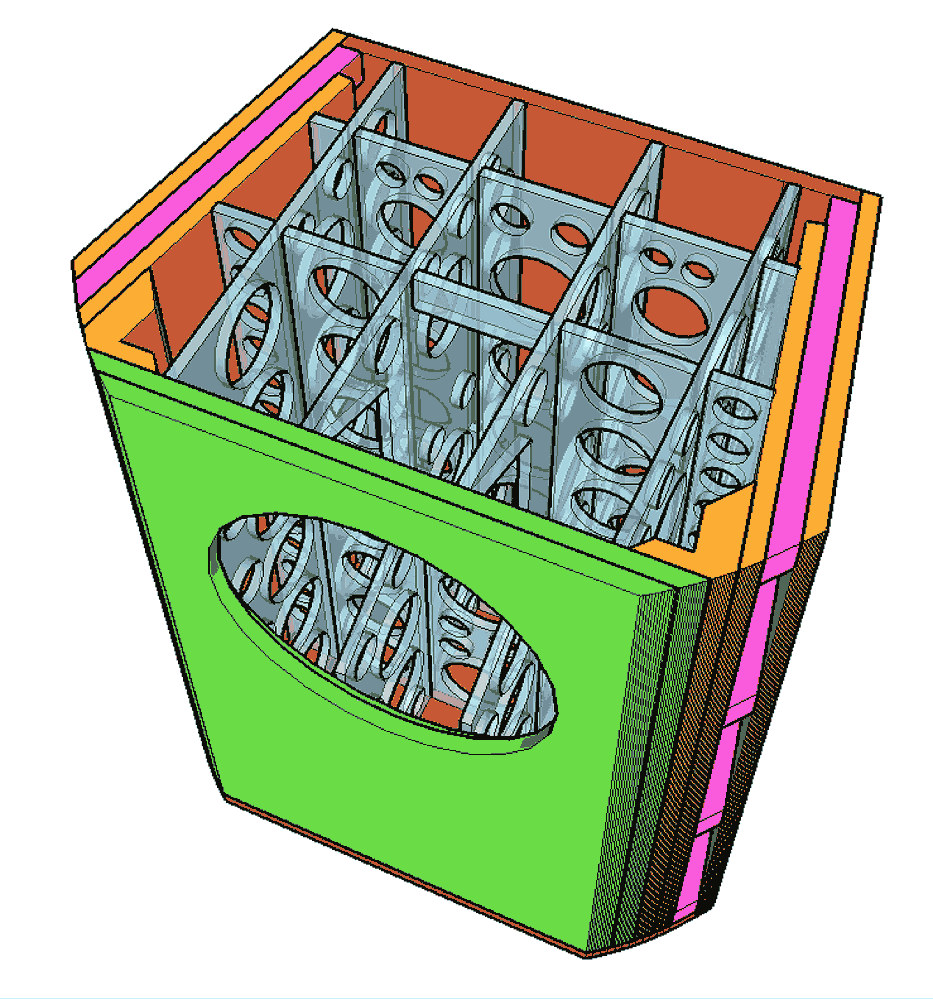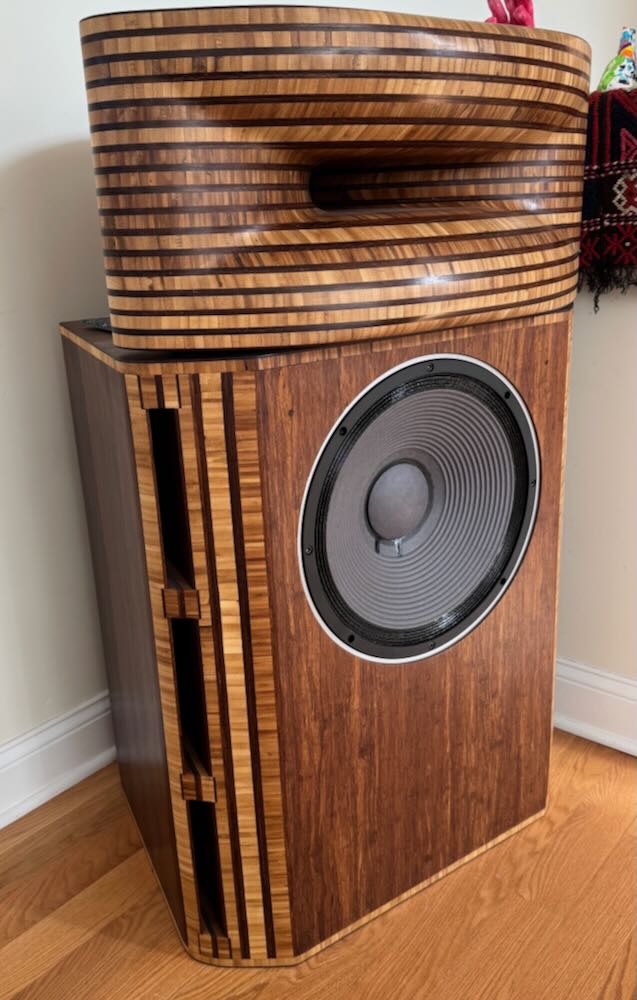Hi All,
I have a pair of TAD TD-2001 I planned to use with a A-480 Yuichi Arai or Joseph Crowe ES-600 horns.
My original plan was to pair them with Fostex FW305 (12 inch) and cross around 800hz give or take.
Now a pair of TAD TL-1601A (15 inch) became available for a good price. So I’m wondering if i should change course and go with those instead.
I haven’t seem many people online use these two in a twoway system, usually they pair them with a bigger 300hz horns and 4001’s (4 inch). Like in the 2402. Although the 1601’s seem te be useable to about 1,2kHz.. so im thinking why not?
Only problem i can think of would be the directivity matching. Let me know your thoughts.
I have a pair of TAD TD-2001 I planned to use with a A-480 Yuichi Arai or Joseph Crowe ES-600 horns.
My original plan was to pair them with Fostex FW305 (12 inch) and cross around 800hz give or take.
Now a pair of TAD TL-1601A (15 inch) became available for a good price. So I’m wondering if i should change course and go with those instead.
I haven’t seem many people online use these two in a twoway system, usually they pair them with a bigger 300hz horns and 4001’s (4 inch). Like in the 2402. Although the 1601’s seem te be useable to about 1,2kHz.. so im thinking why not?
Only problem i can think of would be the directivity matching. Let me know your thoughts.
if not in need of high spl, cross the TD-2001 lower on Arai 480 or Yamamoto SS-500 ?
Then the TL-1601A is a better choice.
Clever use of cabinet shape can help shape the directivity.
Then the TL-1601A is a better choice.
Clever use of cabinet shape can help shape the directivity.
I’m also a bit worried going any lower, i’m not to keen to replace the diaphragms…
@marco_gea could you elaborate on the pro’s and con’s to each?
@Arez what kind of cabinet shapes would help with this?
@marco_gea could you elaborate on the pro’s and con’s to each?
@Arez what kind of cabinet shapes would help with this?
FW305) pros: smaller box for similar bass extension, wider beamwidth (less directivity) at 800Hz
Cons: more excursion required for same SPL output (hence more distortion at HIGH SPLs)
TL-1601A (or -B)) pros: less excursion required for same SPL output (hence less distortion at HIGH SPLs)
cons: narrower beamwidth (more directivity) at 800Hz, bigger box for similar bass extension
Cons: more excursion required for same SPL output (hence more distortion at HIGH SPLs)
TL-1601A (or -B)) pros: less excursion required for same SPL output (hence less distortion at HIGH SPLs)
cons: narrower beamwidth (more directivity) at 800Hz, bigger box for similar bass extension
@Arez what kind of cabinet shapes would help with this?
I believe that you can use the shape of your loudspeaker as a waveguide.
I've mentioned this offhand in a few threads, but I thought I'd provide some evidence. Basically I'd been obsessing about the shape of my newest loudspeaker and some people were wondering why I was being so obsessive about the width and the depth of the enclosure.
The answer? Because the width and the depth of the enclosure act as a waveguide.
To demonstrate, here's a 35.6cm wide waveguide mounted in a baffle that 122cm wide:

In this sim, you can see the expected...
I've mentioned this offhand in a few threads, but I thought I'd provide some evidence. Basically I'd been obsessing about the shape of my newest loudspeaker and some people were wondering why I was being so obsessive about the width and the depth of the enclosure.
The answer? Because the width and the depth of the enclosure act as a waveguide.
To demonstrate, here's a 35.6cm wide waveguide mounted in a baffle that 122cm wide:

In this sim, you can see the expected...
- Patrick Bateman
- Replies: 81
- Forum: Multi-Way
https://orbit.dtu.dk/files/296069309/SMO_Manuscript_PRA_accepted_final_edit.pdf
https://audiohorn.net/mid-range-beaming-and-narrowing/
For example there is a reason why most 'pa' speakers using a 1" and 12/15" crossed high for spl uses a trapezoidal enclosure.
Look at examples from JBL, Yamaha, Peavey, Meyer etc.
sorry for the short answer, but there is plenty to read. And im busy for some days.
Thanks and yes, that's about what I was thinking. I'm just not sure how much the resulting off-axis dip will be noticeable. I have quite a reverberant room so i'm afraid it will color the sound.FW305) pros: smaller box for similar bass extension, wider beamwidth (less directivity) at 800Hz
Cons: more excursion required for same SPL output (hence more distortion at HIGH SPLs)
TL-1601A (or -B)) pros: less excursion required for same SPL output (hence less distortion at HIGH SPLs)
cons: narrower beamwidth (more directivity) at 800Hz, bigger box for similar bass extension
Thank you! Don't be sorry, this helps. Looks like I have some reading to do. 🙂I believe that you can use the shape of your loudspeaker as a waveguide.
I've mentioned this offhand in a few threads, but I thought I'd provide some evidence. Basically I'd been obsessing about the shape of my newest loudspeaker and some people were wondering why I was being so obsessive about the width and the depth of the enclosure.
The answer? Because the width and the depth of the enclosure act as a waveguide.
To demonstrate, here's a 35.6cm wide waveguide mounted in a baffle that 122cm wide:

In this sim, you can see the expected...
- Patrick Bateman
- Replies: 81
- Forum: Multi-Way
https://orbit.dtu.dk/files/296069309/SMO_Manuscript_PRA_accepted_final_edit.pdf
https://audiohorn.net/mid-range-beaming-and-narrowing/
For example there is a reason why most 'pa' speakers using a 1" and 12/15" crossed high for spl uses a trapezoidal enclosure.
Look at examples from JBL, Yamaha, Peavey, Meyer etc.
sorry for the short answer, but there is plenty to read. And im busy for some days.
@planet10 Looks like the example you send uses a bigger horn then i intent to use. Sorta mitigates the problem I'm facing. Or does that cab adress some directivity issue like Arez mentioned? Looks good though!
@planet10 Looks like the example you send uses a bigger horn then i intent to use.
It is a Yuchi horn, with extended termination and made to the size of the woofer enclosure.
dave
It is a Yuchi horn, with extended termination and made to the size of the woofer enclosure.
dave
It looks like a Joseph Crowe horn to me...
The horn in the photograph that you posted is different from the ones in your sketches.
The former is a real product, and it most definitely is a J. Crowe horn; the latter may well be your own modified Arai's (but they're drawings...).
The former is a real product, and it most definitely is a J. Crowe horn; the latter may well be your own modified Arai's (but they're drawings...).
You're painting yourself into a corner, by being so stubborn.
(I) The horn in the photo is a J. Crowe horn. It's an exponential (or possibly hypex) quasi-radial horn, loosely similar in basic design to a Yuichi, of course, but by that same vague metric, you could equally claim that it's a TAD, or a Yamamoto, or a Fostex, or even an Altec, etc.
But it also differs from those in that it's CNC-milled as a single, continuous contour, with no sharp edges, no parallel walls, no vanes (though some of the Yuichi horns have no vanes either), and no throat adapter. And of course, as you now concede, it also differs because it sports a much larger roundover at the mouth, which incidentally makes it significantly larger overall than a Yuichi for the same design cut-off (e.g., compare Crowe's ES290 with Yuichi's A290).
(II) Conversely, the horns that you later posted in your b/w sketches do look a lot more like traditional Yuichi horns, with straight walls and parallel surfaces, vanes, flat-plate throat adapters, etc. In fact, they are probably exact clones of Yuichi's design, with only minor cosmetic external additions to integrate them better with your bass boxes.
There is not much in common between (I) and (II), except for the very basic fundamental underlying theory.
(I) The horn in the photo is a J. Crowe horn. It's an exponential (or possibly hypex) quasi-radial horn, loosely similar in basic design to a Yuichi, of course, but by that same vague metric, you could equally claim that it's a TAD, or a Yamamoto, or a Fostex, or even an Altec, etc.
But it also differs from those in that it's CNC-milled as a single, continuous contour, with no sharp edges, no parallel walls, no vanes (though some of the Yuichi horns have no vanes either), and no throat adapter. And of course, as you now concede, it also differs because it sports a much larger roundover at the mouth, which incidentally makes it significantly larger overall than a Yuichi for the same design cut-off (e.g., compare Crowe's ES290 with Yuichi's A290).
(II) Conversely, the horns that you later posted in your b/w sketches do look a lot more like traditional Yuichi horns, with straight walls and parallel surfaces, vanes, flat-plate throat adapters, etc. In fact, they are probably exact clones of Yuichi's design, with only minor cosmetic external additions to integrate them better with your bass boxes.
There is not much in common between (I) and (II), except for the very basic fundamental underlying theory.
Also, by flat out stating "it is not", in response to my suggestion that the horn in the photo is a J.Crowe horn, you were basically lying outright.
Last edited by a moderator:
This was the only design that anyone wver paid me enuff to own the rights to the design (bass unit). Hopefully Aaron will chip win, i have poked him about the Yuchi and you can ask him if he is willing to share.
dave
dave
Last edited:
Hello everyone,
Just to clear up any questions, the original design was the bass cabinet designed by Dave to work with a Yuichi horn. As we tested the Yuichi, we reached out to Troy Crowe of Joseph Crowe Audio. We worked with Troy to improve upon the Yuichi and eventually arrived at his ES-290 horn. We license the design from Troy, and were one of his earliest adopters. They are a noticeable improvement over the standard Yuichi.
Aaron
Just to clear up any questions, the original design was the bass cabinet designed by Dave to work with a Yuichi horn. As we tested the Yuichi, we reached out to Troy Crowe of Joseph Crowe Audio. We worked with Troy to improve upon the Yuichi and eventually arrived at his ES-290 horn. We license the design from Troy, and were one of his earliest adopters. They are a noticeable improvement over the standard Yuichi.
Aaron
- Home
- Loudspeakers
- Multi-Way
- Seeking advice for TAD two way


